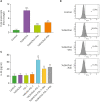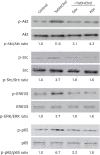Glucocorticoids Impair the 7α-Hydroxycholesterol-Enhanced Innate Immune Response
- PMID: 37970232
- PMCID: PMC10643330
- DOI: 10.4110/in.2023.23.e40
Glucocorticoids Impair the 7α-Hydroxycholesterol-Enhanced Innate Immune Response
Abstract
Glucocorticoids suppress the vascular inflammation that occurs under hypercholesterolemia, as demonstrated in an animal model fed a high-cholesterol diet. However, the molecular mechanisms underlying these beneficial effects remain poorly understood. Because cholesterol is oxidized to form cholesterol oxides (oxysterols) that are capable of inducing inflammation, we investigated whether glucocorticoids affect the immune responses evoked by 7α-hydroxycholesterol (7αOHChol). The treatment of human THP-1 monocytic cells with dexamethasone (Dex) and prednisolone (Pdn) downregulated the expression of pattern recognition receptors (PRRs), such as TLR6 and CD14, and diminished 7αOHChol-enhanced response to FSL-1, a TLR2/6 ligand, and lipopolysaccharide, which interacts with CD14 to initiate immune responses, as determined by the reduced secretion of IL-23 and CCL2, respectively. Glucocorticoids weakened the 7αOHChol-induced production of CCL2 and CCR5 ligands, which was accompanied by decreased migration of monocytic cells and CCR5-expressing Jurkat T cells. Treatment with Dex or Pdn also reduced the phosphorylation of the Akt-1 Src, ERK1/2, and p65 subunits. These results indicate that both Dex and Pdn impair the expression of PRRs and their downstream products, chemokine production, and phosphorylation of signaling molecules. Collectively, glucocorticoids suppress the innate immune response and activation of monocytic cells to an inflammatory phenotype enhanced or induced by 7αOHChol, which may contribute to the anti-inflammatory effects in hypercholesterolemic conditions.
Keywords: 7α-Hydroxycholesterol; GlucocorticoidsMonocytes/macrophages; Inflammation; Pattern recognition receptors.
Copyright © 2023. The Korean Association of Immunologists.
Conflict of interest statement
Conflict of Interest: The authors declare no potential conflicts of interest.
Figures






References
-
- Bailey JM, Butler J. Anti-inflammatory drugs in experimental atherosclerosis. I. Relative potencies for inhibiting plaque formation. Atherosclerosis. 1973;17:515–522. - PubMed
-
- Asai K, Funaki C, Hayashi T, Yamada K, Naito M, Kuzuya M, Yoshida F, Yoshimine N, Kuzuya F. Dexamethasone-induced suppression of aortic atherosclerosis in cholesterol-fed rabbits. Possible mechanisms. Arterioscler Thromb. 1993;13:892–899. - PubMed
-
- Poon M, Gertz SD, Fallon JT, Wiegman P, Berman JW, Sarembock IJ, Taubman MB. Dexamethasone inhibits macrophage accumulation after balloon arterial injury in cholesterol fed rabbits. Atherosclerosis. 2001;155:371–380. - PubMed
-
- Joner M, Morimoto K, Kasukawa H, Steigerwald K, Merl S, Nakazawa G, John MC, Finn AV, Acampado E, Kolodgie FD, et al. Site-specific targeting of nanoparticle prednisolone reduces in-stent restenosis in a rabbit model of established atheroma. Arterioscler Thromb Vasc Biol. 2008;28:1960–1966. - PubMed
LinkOut - more resources
Full Text Sources
Research Materials
Miscellaneous

